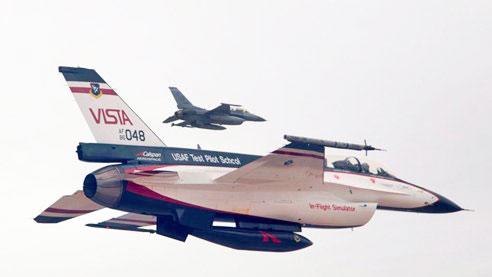AirForceResearchLaboratory
Latest

Air Force tests air-to-ground strikes with an autonomous F-16 wingman
There's so much focus around autonomous cars these days it's easy to forget that the military's trying to plug artificial intelligence into fighting vehicles, too. And not just in computer mock-ups, like last June's exhibition wherein a flight AI beat a retired USAF Colonel in simulated dogfights. In a recent test, military contractors used an unmanned system autonomously flying an F-16 combat jet as a wingman to support a human pilot in a separate aircraft. The system successfully met its goals to adapt, plan and execute maneuvers all on its own.

US military tries using small electric jolts to keep soldiers awake
Soldiers don't have many options for overcoming sleep deprivation outside of a good cup of coffee. If the Air Force Research Laboratory's experiments prove successful, though, troops may rely on tiny jolts of electricity to stay alert. By using a mild current to stimulate key parts of the brain, the military's scientists can keep people awake and focused for long periods -- up to 30 hours in recent trials. The existing technique produces modest side effects like skin irritation and short headaches, and it's unlikely to reach civilians any time soon. However, a refined version could eventually prove crucial to drone pilots and other warriors who can't afford to take naps during crucial missions. [Image credit: John Kricfalusi]

US Air Force orders up 2,200 more PS3s -- for thinking, not gaming
We were as surprised as anyone when the USAF threw down the cash for 300-odd PlayStation 3s back in March of last year, but what's more shocking is that it's now back for more -- seven times more, in fact. Already employing its PS3 cluster for research into high-def video processing, the Air Force Research Lab wants to expand its capabilities significantly and it seems that Sony's Cell processor is still its weapon of choice. We would use this opportunity to make a few jibes about lazy engineers upgrading their setups in time for Modern Warfare 2, but we're better than that. We'll also totally avoid noting that the US government's skimping on costs now is leading it to commit to an instruction set tailored specifically to the Cell processor, which contrary to the latest Xeons -- pricier though they may be -- is not guaranteed to keep updating in pace with the USAF's needs. Those are things we'll leave for someone who isn't afraid of death lasers and autonomous attack drones to say.

Boeing to develop microwave-based airborne EMP weapon
Boeing's been busy with the high-tech death lately -- just a week after the company announced the Phantom Ray fighter UAV, it's back in the news with a high-powered airborne microwave weapon designed to knock out enemy electronics. The goal is to more or less destroy the enemy's tech with out having to set off one of those pesky nuclear explosions necessary for an EMP, and Boeing plans to test the tech out both in the air and on the ground several times over the next three years as part of the Air Force's Counter-electronics High power microwave Advanced Missile Project (CHAMP) project. We'll be ready with the popcorn. [Via The Register]

Air Force developing UAVs that can recharge on power lines
We've seen some interesting solutions to keeping UAVs powered for extended missions, but none so diabolical as actually landing on the enemy's power lines and using their juice to power up. That's the plan behind the Power Line Urban Sentry (PLUS) project currently being run by the Air Force Research Laboratory and private firm Defense Research Associates, and it's already yielded UAVs that can land on power lines and charge in three hours. The project started with attempts to charge by simply flying near power lines, but when that method yielded only micro-watts of juice, focus shifted to actually landing on the lines. The team is planning all sorts of other capabilities for the tech, including navigation systems -- "Power lines are like highways in the sky," says one of the researchers -- and auxiliary surveillance systems that power up when jacked in. On top of all that awesomeness, the team is also working with an outfit called the Center for Morphing Control to disguise the UAVs when they sit on the lines -- so far, they say, they've made a small UAV "look like a Coke can." Test flights are scheduled for 2008, and there's still work to be done on the power line latching mechanism, but whatever -- we want one.[Thanks, Stuart T., original photo by Bob Fornal]

